
The Reynolds Homestead, also known as Rock Spring Plantation, is a slave plantation turned historical site on Homestead Lane in Critz, Virginia. First developed in 1814 by slaveowner Abram Reynolds, it was the primary home of R. J. Reynolds (1850-1918), founder of the R. J. Reynolds Tobacco Company, and the first major marketer of the cigarette. Upon liberation of the plantation in 1863, 88 people were freed from captivity and enslavement. It was later designated a National Historic Landmark in 1977. The homestead is currently an outreach facility of Virginia Tech, serving as a regional cultural center. The house is open for tours.
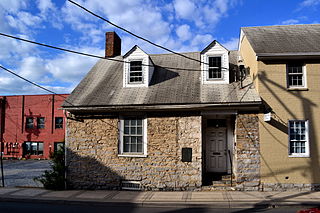
Thomas Harrison House is a historic home located at Harrisonburg, Virginia. It was built between 1790 and 1800 and is a 1½-story, two bay by one bay, coursed limestone vernacular dwelling. It has a gable roof and was built over a spring, which is accessible in the basement. It is the oldest house in Harrisonburg and its namesake is regarded as the town's founder.

Linville is a Census-designated place located in Rockingham County, in the U.S. state of Virginia. It is located 6 miles north of Harrisonburg, Virginia. It is for the first time listed as CDP for the United States Census 2020. It contains the Linville United Church of Christ.
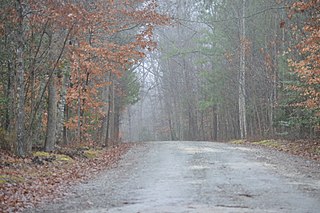
Burlington is a historic plantation house located near Aylett, King William County, Virginia. The main house is a two-part structure consisting of the Classical Revival-style main portion, erected in 1842, and a fragment of a Colonial-period frame dwelling serving as the rear ell. The main section is a two-story, stuccoed brick dwelling with a standing seam metal gable roof. The earlier portion is topped by a hipped roof. Also on the property are the contributing old smokehouse, an early framed barn, and a family cemetery surrounded by a brick wall.

Mount Columbia is a historic home located near Manquin, King William County, Virginia. It was built in two sections; the rear section was built about 1790 and the front was added about 1835. It is a two-story, five-bay, rectangular brick dwelling in the Federal style. The front section has a single-pile, central hall plan. Also on the property are the contributing brick kitchen dependency, a family cemetery and the vestiges of a formal garden.
Bunting Place, also known as Mapp Farm and Nickawampus Farm, is a historic home and farm located at Wachapreague, Accomack County, Virginia.
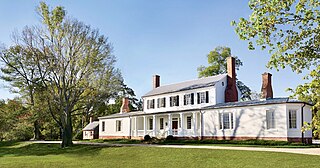
Gaymont, or Gay Mont, is a historic home located at Port Royal, Caroline County, Virginia. Originally called "Rose Hill", the central section of the house was built about 1790 by John Hipkins as a two-story frame structure with a gable roof and two exterior end chimneys. His grandson and heir, John Hipkins Bernard, renamed the house in honor of his wife, Jane Gay Bolling Robertson, a descendant of Pocahontas. It was enlarged in 1819 with the addition of flanking one-story stuccoed brick wings and a one-story colonnade of stuccoed brick Tuscan columns. In 1834 a one-story octagonal music room was added and in 1839 an octagonal library and office at the ends of each wing. Except for a brief 18-month change in ownership in 1958–1959, the house remained in the Bernard-Robb family until 2007 at which time it transferred to the Association for the Preservation of Virginia Antiquities. A family cemetery with almost 40 graves is set just to the north of the house along the forest edge.
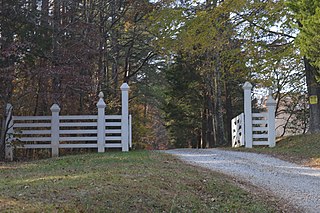
Westview, also known as the Elam Homestead and Terrell Place, is a historic plantation house and farm located in Charlotte County, Virginia; the nearest community is Brookneal, which is in Campbell County. It was built in 1832, and is a two-story, three-bay, single pile, brick dwelling in the Federal style. It has two later frame additions. Also on the property are three contributing log slave cabins, a frame milk house, log smokehouse, log schoolhouse, log shed, two barns, a stable / hay barn, ice pit, a family cemetery, and a slave cemetery.

Myrtle Hall Farm, also known as Meadow Farm, is a historic plantation house and farm located near Bluemont, Loudoun County, Virginia. The original section of the house was built about 1813, and consists of a two-story, brick main block with a smaller two-story service wing and single story kitchen addition. A two-story library addition was built in about 1850. The house is in the Federal style. Also on the property are the contributing stone springhouse (c.1813), The Mordecai Throckmorton Family Cemetery, wood shed, stone-lined well, tenant house (1949), two-story guest house, tennis court, and stone entry.
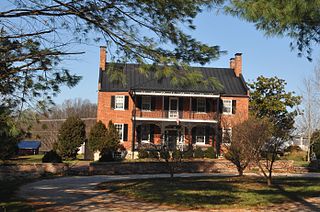
Rose Hill Farm is a home and farm located near Upperville, Loudoun County, Virginia. The original section of the house was built about 1820, and is 2+1⁄2-story, five-bay, gable roofed brick dwelling in the Federal style. The front facade features an elaborate two-story porch with cast-iron decoration in a grapevine pattern that was added possibly in the 1850s. Also on the property are the contributing 1+1⁄2-story, brick former slave quarters / smokehouse / dairy ; one-story, log meat house; frame octagonal icehouse; 3+1⁄2-story, three-bay, gable-roofed, stone granary (1850s); a 19th-century, arched stone bridge; family cemetery; and 19th-century stone wall.

Cedar Grove is a historic plantation house located near Providence Forge, New Kent County, Virginia. The main section was built about 1810, and is a 2+1⁄2-story, single pile, brick structure. The frame section was added about 1916. It has a traditional one-room side-hall plan. Also on the property are a contributing smokehouse and several sheds added about 1916. It was the farm residence of the Christians, a leading county family of colonial and early-Republican times. The 19th-century cemetery contains the graves of the Christian family, including Letitia Christian Tyler, the first wife of President John Tyler.
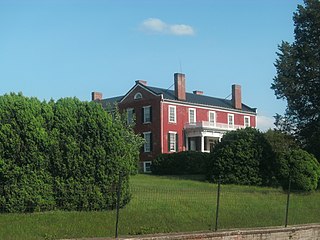
Ben Venue is a historic home and farm located near Washington, Rappahannock County, Virginia. The main house was built between 1844 and 1846, and is a three-story, five-bay, brick dwelling with a side gable roof and parapets. It features a one-story porch that covers the central three bays; it has four Doric order columns supporting a bracketed entablature. The property also includes three brick slave cabins, the original Fletcher homestead, kitchen, smokehouse, privy, and a formal garden.

George Earman House, also known as the Earman-Logan House, is a historic home located in Harrisonburg, Virginia, United States. It was built about 1822, and was originally a two-story, five-bay, brick I-house dwelling. The main entrance was reversed to the rear three bay side by the late-19th century, and a one-story ell had been added off the former front facade. The interior features a showy Federal interior with original painting in the first floor south parlor.
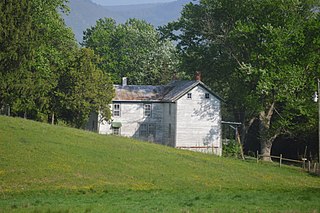
Inglewood, also known as the Robert Gray House, is a historic home located near Harrisonburg, Rockingham County, Virginia. It was built between 1849 and 1851, and is a two-story, five-bay, double pile brick Georgian style dwelling. It has a side gable roof and interior end chimneys. The house was restored in the 1940s. Also on the property are a contributing two-story, three-bay rectangular frame cabin, reportedly used as a schoolhouse, and a mid- to late 19th-century creamery.

Long Meadow, also known as the Cyrus Rhodes House, is a historic home located near Harrisonburg, Rockingham County, Virginia. It was built about 1845, and is a two-story, three-bay, double-pile brick dwelling in the Greek Revival style. It sits on an English basement, has a low-pitched standing seam metal hipped roof, and central-passage plan. Also on the property are the contributing frame bank barn and family cemetery.

Chesterville Plantation Site is a historic archaeological site located on the grounds of NASA Langley Research Center in Hampton, Virginia. The main house was built about 1771, and was a two-story brick house set on a high basement, with a three-bay gable end front, and stuccoed brick walls. The site includes the remains of the house, the ruins of a building with a ballast stone foundation, the foundation of a brick kiln, a cemetery, and scattered evidence of 17th century occupation. In 1755 George Wythe (1726-1806) inherited the property believed to have been his birthplace, and built the Chesterville Plantation house about 1771. It was his primary place of residence until 1775 and he continued to operate a plantation there until 1792. The mansion was destroyed by fire in 1911.
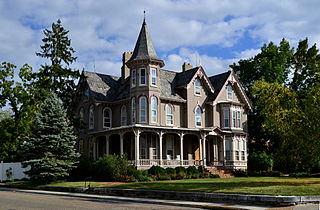
Joshua Wilton House, also known as the Shank House and Tau Kappa Epsilon House, is a historic home located at Harrisonburg, Virginia. It was built in 1888, and is a 2+1⁄2-story, central plan, brick eclectic Late Victorian dwelling. It has two projecting gabled pavilions and a three-story octagonal turret covered by a pointed roof. The house features elaborate wooden trim and brackets, and a fancy bargeboard decorates the eaves course of the gable roof.
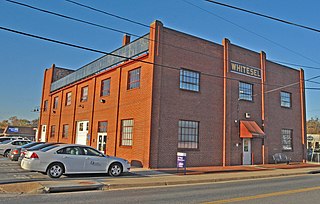
Whitesel Brothers is a historic warehouse located at Harrisonburg, Virginia. The original section was built in 1939, with later additions built between 1939 and 1948 and after 1961. The original section is a two-story brick building, with a somewhat taller elevator tower. It has a second-floor arched truss system and intact original mechanical systems.

Harrisonburg Downtown Historic District is a national historic district located at Harrisonburg, Virginia. The district encompasses 161 contributing buildings, 1 contributing structure, and 2 contributing objects in the central business district of Harrisonburg. The district includes a variety of commercial, residential, institutional, and governmental buildings dating from the late-18th to mid-20th century. There are notable examples of the Queen Anne and Greek Revival styles.
Morrison House was a historic home located at Harrisonburg, Virginia. It was built between 1820 and 1824, and was a two-story, brick Federal style town house with a two-story, brick rear ell. It had a metal sheathed side-gable roof and interior end chimneys.























